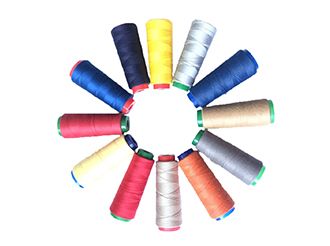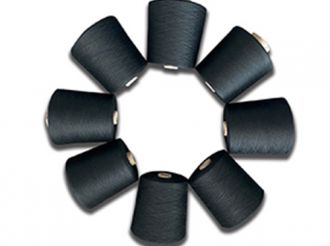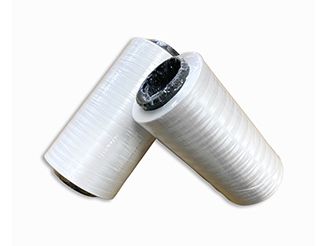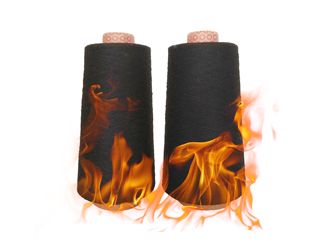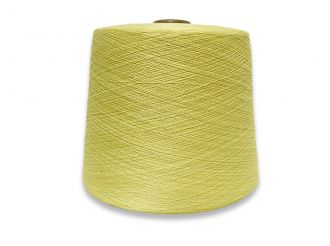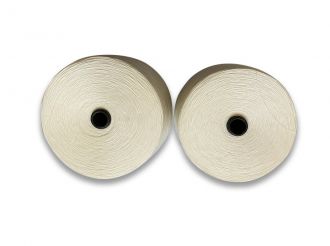What is yarn and its properties?
- 2022-04-22
What is yarn and its properties?
What is yarn?
Yarn is a kind of textile, which is processed into products of a certain fineness with various textile fibers. It is used for weaving, rope making, thread making, knitting and embroidery, etc. It is divided into short fiber yarn, continuous filament, etc.
Yarn is composed of one or more continuous filaments or discontinuous staple fibers. Yarn is actually a general term for yarn and thread. The raw material of yarn is fiber, and yarn is both the raw material and product of clothing fabrics, such as sewing thread, knitting thread, embroidery thread, etc.
There are many ways to express the fineness of yarn, such as Tex, Nm, Ne, denier, etc. (see count). Yarn twist is expressed in turns per meter or inch.
Wool yarns and yarns are generally used to weave wool sweaters, wool pants, wool vests, scarves, hats and gloves and to weave various spring and autumn clothing items.
What kinds of yarns are there?
A. Classification by yarn raw materials
Pure spinning: Pure spinning is a yarn spun from a fibrous material, such as cotton, wool, hemp and silk spinning. Such yarns are suitable for making pure textiles.
Blended yarn: Blended yarn is a yarn spun from two or more fibers, such as polyester and cotton blended yarn, wool and viscose blended yarn, etc. Such yarns are used in fabrics that highlight the advantages of both fibers.
B. Classification by yarn thickness
Rough tex yarn: Rough tex yarn refers to yarns of 32tex and above (18 British counts and below). This type of yarn is suitable for thick fabrics such as tweed, cheesecloth, etc.
Medium tex yarn: Medium tex yarn refers to 21-32tex (19-28 British counts in the British system). This type of yarn is suitable for medium thickness fabrics, such as plain cloth, gabardine, khaki, etc.
Fine tex yarn: Fine tex yarn refers to yarns of 11-20tex (29-54 British counts in the British system). Such yarns are suitable for thin fabrics such as muslin, poplin, etc.
Extra-fine tex yarn: Extra-fine tex yarn refers to the yarn of 10tex and below (58 British count and above). This kind of yarn is suitable for high-grade fine fabrics, such as high-count shirts, worsted cardigans, etc.
C. Classification by yarn use
■ Yarn for weaving. Weaving yarn refers to the yarn used for processing woven fabrics, which is divided into warp yarn and weft yarn. The warp yarn is used as the longitudinal yarn of the fabric, which has the characteristics of large twist, high strength and good wear resistance; the weft yarn is used as the transverse yarn of the fabric, which has the characteristics of small twist, low strength, but softness.
■ Yarn for knitting. Knitting yarns are yarns used in knitted fabrics. The yarn quality requirements are high, the twist is small, and the strength is moderate.
Other yarns. Including sewing thread, embroidery thread, knitting thread, miscellaneous thread, etc. Depending on the application, the requirements for these yarns are different.
■ Single yarn. Single yarn refers to a yarn in which only one fiber bundle is twisted. A pure spun yarn can be spun from one raw material to form a pure woven fabric, or a blended yarn can be formed from two or more raw materials to form a blended fabric.
strands. A strand is a thread formed by twisting two or more single yarns. Its strength and wear resistance are better than single yarn. At the same time, the strands can also be plied, combined and twisted in a certain way to obtain double-stranded strands, such as double-strand strands, three-strand strands, and multi-strand strands. Mainly used for sewing thread, braided thread or medium-thick and strong fabrics.
■ Monofilament. A monofilament is made up of a single fiber filament. Its diameter depends on the thickness of the fiber filament. Generally only used to process thin fabrics or knitted fabrics, such as nylon socks, veils, etc.
■ Textured yarn. Textured yarn is obtained by deforming synthetic fiber filaments from straightening to crimping, also known as textured yarn or processed yarn. Textured yarns include high elastic yarns, low elastic yarns, bulked yarns and network yarns.
■ High elastic wire. High elastic yarn or high elastic textured yarn has high stretchability and general bulkiness. Mainly used for elastic fabrics, mainly nylon high elastic yarn.
■ Low elastic wire. Low-stretch or textured stretch yarns have moderate stretch and bulk. Mostly used for knitted fabrics, mostly polyester low elastic yarn.
■ Bulk yarn. Bulked yarns have low stretch and high bulk. Mainly used for wool, underwear or outerwear and other fabrics that require good bulkiness, its typical representative is acrylic bulky yarn, also known as cashmere.
■ Network wire. Network filament, also known as interlaced filament, is formed by holding some filaments together before they are formed in the process of chemical fiber spinning. This silk is soft to the touch, bulky, and has a good wool-like effect. It is mostly used in women's clothes. The popular golf is also made of this silk.
■ Special yarn, also known as fancy yarn: refers to the special structure and appearance effect obtained by processing fibers or yarns with special raw materials, special equipment or special processes in the process of spinning and thread making. Yarn is a kind of yarn with decorative effect in yarn products. Since 2012, special yarns and fabrics have been displayed at the International Yarns and Fabrics Exhibition. Special yarn woven products can be used as fabrics for coats, suits, outerwear, shirts and skirts; fancy yarn knitted products are widely used to make knitted garments; in addition, fancy yarns are also widely used to weave sweaters , hats, scarves, ties, carpets, etc., as well as decorative fabrics such as yarn release, curtain fabrics, bedding, and high-grade wall materials.
■ Blended (fiber) yarn,blended or intertwisted yarn is a yarn composed of two or more fibers, such as polyester/cotton blended yarn, wool/polyester blended yarn, wool/acrylic blended yarn, polyester/viscose/nitrile blended yarn , silk / cotton yarn twisted yarn and so on. There are two or more kinds of short fibers mixed into short fiber yarn, called blended yarn; and the combination of two or more filament yarns (such as twisting) into the yarn, called mixed yarn.
What is the fineness (count) of the yarn?
Yarn count refers to the thickness of the yarn, which is represented by S, D, N, Tex, Dtex, etc. Specific fabrics use specific specifications, of which S and D are more commonly used. In the scientific literature, tex is generally converted.
Common units of yarn count NM, NE, tex, dtex, Danier?
Metric count (Nm) refers to the length in meters of a gram of yarn (or fiber) at a given moisture regain.
Inch count (Ne) It refers to how many 840 yards of cotton yarn weighing 1 pound (453.6 grams) (wool yarn is 560 yards per pound) (1 yard = 0.9144 meters) long.
S is the inch count, which refers to the yarn weighing one pound at a certain moisture regain, and its length is several 840 yards, which is called several yarns. Generally, the yarn count of staple fiber is represented by S, and the meaning of staple fiber is Staple. The thicker the yarn, the smaller the S value; the thinner the yarn, the larger the S value, for example, the yarn count of 40S is thinner than that of 20S.
D is the abbreviation of Denier, which is a method of expressing the fineness of chemical fibers. Generally, the count of filament is represented by D, and the filament is represented as Filament in English. The larger the D, the thicker the yarn, for example, 75D is thicker than 50D
Tex tex, it refers to the weight of 1000 meters long yarn in grams under the specified moisture regain.
Nm metric count refers to the number of meters in the length of 1 gram of yarn under the specified moisture regain, that is to say, 1 gram of yarn is exactly one meter long as 1 (male) yarn, and the length of 1 gram of yarn is 200 meters long, the fineness of the yarn is 200, so the larger the count, the finer the yarn.
Dtex, or decitex for short, refers to the grams of fiber bundles that are 10,000 meters long.
The following are the conversion formulas of several units
D=5315/S,D=9000/N,Tex=D/9,1Tex=1/10Dtex,Tex=1000/N,Dtex=10D/9,Dtex=10000/N
What is the breaking strength of the yarn, breaking strength, elongation at break?
What is yarn breaking strength? In a yarn tensile test, the specimen is stretched to the maximum force applied to break. For yarns, centiNewtons are preferred.
What is yarn breaking strength? The ratio of yarn breaking strength to its linear density. Usually expressed in centinewtons per tex.
What is elongation at break? The increment in specimen length resulting from the breaking strength is divided by the original length.
What is para-aramid yarn?
Aramid yarn is twisted with aramid 1414 fiber. Aramid fiber has extremely high strength, more than 28 g/denier, which is 5-6 times that of high-quality steel, 2-3 times that of steel or glass fiber, and 2 times that of steel, and its weight is only 2 times that of steel. 1/5. Aramid has a shrinkage rate of 0 at 150 °C, and does not decompose or melt at a high temperature of 500 °C.
What is meta-aramid yarn?
Meta-aramid yarn is a yarn that is worsted and twisted by meta-aramid staple fibers, and will not undergo significant decomposition and carbonization below 400 degrees Celsius. When the temperature exceeds 400 ℃, the fiber gradually becomes brittle, carbonized until decomposed, but no droplets are produced; it self-extinguishes in the flame, and has good flame retardancy. The limiting oxygen index (LOI) is 29%-32%, and the performance is extremely good.
What is pre-oxidized fiber yarn?
Pre-oxidized fiber yarn is twisted by pre-oxidized fiber, limiting oxygen index is above 45%, with excellent thermal stability, no melting, no dripping, no softening and no shrinkage, excellent flame retardant, high temperature resistance and heat resistance performance.
What is blended yarn and what is composite yarn?
Blended yarn: Blended yarn is a yarn spun from two or more fibers, such as polyester and cotton blended yarn, wool and viscose, para-aramid and meta-aramid, para-aramid Fiber and pre-oxidized fiber, pre-oxidized fiber and viscose, para-aramid fiber and carbon fiber, blended yarn of meta-aramid fiber and carbon fiber, etc. Such yarns are used in fabrics that highlight the advantages of both fibers.
Composite Yarn: Two different fibers are intertwined as single yarns or filaments in a ply-like structure, which can be spun on a modified spinning frame or on a hollow spindle. There are mainly siro spinning, serofer spinning, wrapping spinning, core spinning and so on.
What is pre-oxidized fiber and aramid blended yarn?
The blended yarn of aramid and pre-oxidized fiber is blended by para-aramid and pre-oxidized fiber in a certain proportion. Compared with the yarn of pure pre-oxidized fiber, it improves the strength of the yarn and enriches the yarn. The color of the thread improves the abrasion resistance and wearability of the yarn, and the temperature resistance and flame retardant effect is better than that of the para-aramid yarn. The general blending ratio is 60/40 50/50 30/70 etc. It can be used as the fabric of fireproof clothing, and the effect is better after being covered with aluminum foil.
What is yarn twist?
Yarn twist means that in order to make the yarn have certain physical and mechanical properties such as strength, elasticity, elongation, luster, and feel, the yarn must be changed by twisting, and the yarn twisting can be achieved by changing the fiber structure.
The degree of twist directly affects the strength of the yarn. Under the premise of the same raw material and thickness, increasing the twist of the yarn will improve the strength of the yarn. However, when the twist continues to increase, the increase of the yarn strength will gradually slow down. When the twist increase exceeds a certain value, the yarn strength will decrease instead. This value is the critical twist.
The degree of twist also directly affects the quality of yarn and fabric. Generally speaking, too much twist will make the yarn feel hard, easy to knot, the fabric luster is not soft, and the elasticity and softness are also poor. On the contrary, the surface hairiness of the yarn and fabric is more, the hand feels soft and the luster is soft.
What is the new type of spinning?
New spinning methods: rotor spinning, air-jet spinning, friction spinning, self-twist spinning, vortex spinning, parallel spinning, etc., the processing flow, spinning principle, processing equipment and its application.
What is sewing thread?
Sewing thread is the thread required for knitted clothing products. Sewing thread can be divided into three categories according to raw materials: natural fiber, synthetic fiber sewing thread and mixed sewing thread. With the development of the polyester industry, more and more pure polyester fibers are used as raw materials for sewing threads. In addition, high-performance, high-strength, flame-retardant and fire-resistant sewing threads made of para-aramid and meta-aramid are becoming more and more widespread.
What is a strand?
A strand is a thread formed by twisting two or more single yarns. Its strength and wear resistance are better than single yarn.
At the same time, the strands can also be plied, combined and twisted in a certain way to obtain double-stranded strands, such as double-strand strands, three-strand strands, and multi-strand strands. Mainly used for sewing thread, braided thread or medium-thick and strong fabrics.
What is single yarn?
Single yarn refers to a yarn in which only one fiber bundle is twisted. A pure spun yarn can be spun from one raw material to form a pure woven fabric, or a blended yarn can be formed from two or more raw materials to form a blended fabric.
strands. A strand is a thread formed by twisting two or more single yarns. Its strength and wear resistance are better than single yarn. At the same time, the strands can also be plied, combined and twisted in a certain way to obtain double-stranded strands, such as double-strand strands, three-strand strands, and multi-strand strands. Mainly used for sewing thread, braided thread or medium-thick and strong fabrics.
What are carding and combing?
Carding: It is to pass the cotton lap through the carding machine to remove impurities and short piles, so that the fibers are in one direction to a certain extent, and the cotton sliver is made for the next process (drawing frame).
Combing: It is equivalent to an additional process, that is, the carded sliver is drawn into a roll, and then further combed by a comber, the purpose is to further remove the short lint and impurities in the fiber, and make the fiber straight and parallel. better. In this way, the combed sliver is made for the next process (draw frame). The cotton yarn produced in this way has high strength, good evenness and good luster. Usually used for the production of high quality yarns or high count yarns.
What is yarn regain?
Moisture regain is an indicator of the degree of moisture absorption of textile materials. Expressed as a percentage of the weight of the moisture content in the material to the weight of the dry material. In the trade of textiles, in order to meet the needs of weight calculation and price verification, it is necessary to make uniform regulations on the moisture regain of various textile materials, which is called the official moisture regain.
What is fireproof yarn?
Fire-resistant yarn refers to the yarn made of flame-retardant fibers (such as para-aramid fiber, meta-aramid fiber, pre-oxidized fiber, carbon fiber, PTFE, PBO and other flame-retardant fibers). Burns, or can self-extinguishing immediately after burning, no harmful gas is produced. There is also a flame retardant yarn, which is impregnated with a layer of flame retardant on the surface of ordinary yarn, but the flame retardant effect is not very good. In this way, in the event of a fire, the fire-retardant and flame-retardant yarn can keep people's lives and property to the greatest extent possible.
What is high temperature resistant yarn?
High temperature resistant yarns are yarns spun from high temperature resistant materials (such as para-aramid fibers, meta-aramid fibers, pre-oxidized fibers, carbon fibers, PTFE, PBO and other high temperature resistant materials). Maintain the same strength and performance. For example, para-aramid yarn still has very good breaking strength and flame retardant performance at 260°C. The working temperature of the yarn can reach about 1000 ℃.
What is functional yarn?
Functional fabric means that by changing the properties of the fabric, adding functional materials, and adding various auxiliaries in the production process or after finishing, the fabric itself has special effects and super performance that ordinary clothing fabrics do not have.
What is short fiber yarn and what is continuous filament yarn?
Short fiber yarn is made of short fiber (natural short fiber or chemical fiber cut fiber) by spinning, and it is divided into ring-spun yarn, free-end spinning, self-twisting yarn, etc.
Continuous filament yarns, such as natural silk and chemical fiber filaments, are available in twisted or untwisted, smooth or textured filaments.
What are the commonly used spinning raw materials?
Cotton, polyester, ramie, nylon, wool, rabbit hair, cashmere, modal, tencel, linen, silk, acrylic, viscose, para-aramid, meta-aramid, pre-oxidized fiber, carbon fiber, PTFE, etc.
